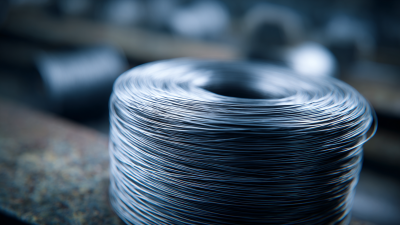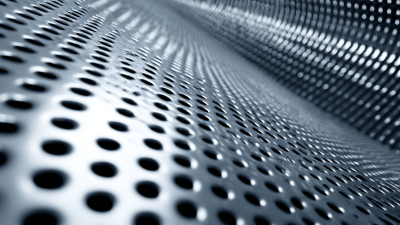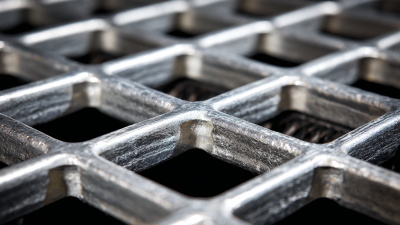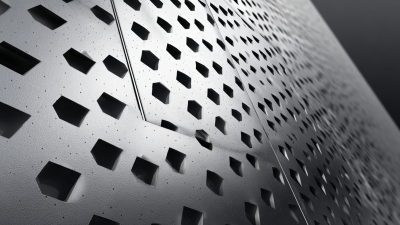Cart
Understanding Expanded Metal: The Versatile Material Transforming Modern Architecture and Design
In recent years, expanded metal has emerged as a groundbreaking material in the field of modern architecture and design. Its unique properties and versatility have garnered attention from architects and designers alike, leading to creative applications in various projects around the world. This inventive material is not just functional; it also adds a contemporary aesthetic that enhances both exterior and interior spaces. From facades and railings to decorative panels and furniture, expanded metal is transforming traditional design paradigms with its ability to blend strength, durability, and visual appeal.
As we explore the top ten remarkable uses of expanded metal, we will uncover how this innovative material is reshaping the landscape of architectural design. Each application highlights the strengths of expanded metal, showcasing its adaptability and the numerous benefits it offers. By examining these compelling examples, we gain insights into the endless possibilities that expanded metal presents, and we can appreciate its role in pushing the boundaries of modern architecture. In this discussion, we aim to celebrate this versatile material that not only meets the demands of functionality but also inspires creativity and style in contemporary design.

Exploring the Unique Properties of Expanded Metal in Architectural Design
Expanded metal is a groundbreaking material that is increasingly being utilized in architectural design due to its unique properties. The manufacturing process, which involves cutting and stretching a solid sheet of metal, results in a lightweight yet robust structure. This versatility allows architects to create facades, screens, and partitions that not only fulfill functional requirements but also enhance aesthetic appeal. The openness of expanded metal provides a distinctive balance between transparency and solidity, allowing natural light to permeate spaces while offering privacy and security.
Moreover, the adaptability of expanded metal enables its application in a variety of environments, from commercial buildings to urban parks. Its ability to resist corrosion and withstand harsh weather makes it a durable choice for outdoor installations. Additionally, expanded metal can be finished in numerous ways, allowing designers to achieve specific visual effects and integrate the material seamlessly with other elements of a project. As sustainable building practices become more prominent, expanded metal's recyclability and minimal material waste in production further underscore its role as a transformative material in modern architecture.
Innovative Applications of Expanded Metal in Modern Infrastructure
Expanded metal is rapidly gaining traction in modern architecture and design due to its versatility and innovative capabilities. Its unique structure, which involves the process of cutting and stretching metal sheets, allows for a lightweight yet sturdy material that can be utilized in a myriad of applications. A report from the Global Expanded Metal Market states that the demand for expanded metal is forecasted to grow by 5.4% annually, reflecting its increasing use in construction projects worldwide.
One of the most compelling applications of expanded metal is in facades and cladding systems. Not only does it enhance the aesthetic appeal of buildings, but it also provides functional benefits such as energy efficiency and safety. For example, the incorporation of expanded metal screens can reduce solar heat gain while allowing natural light to permeate the space. Additionally, its use in urban infrastructure, such as pedestrian walkways and bridges, adds an element of security and sustainability.
Tips: When selecting expanded metal for a project, consider the type of metal and coating to ensure durability and weather resistance. Be mindful of the patterns and openings, as these can significantly affect the light and air flow in architectural designs. Also, look for certified suppliers who adhere to industry standards to guarantee quality and performance.
Creating Aesthetic and Functional Spaces with Expanded Metal
Expanded metal is rapidly becoming a favorite among architects and designers due to its unique ability to balance aesthetics with functionality. This versatile material, created by slitting and stretching metal sheets into a mesh, allows for a range of design possibilities. Its open framework not only provides a visually striking appearance but also facilitates airflow and natural light, making it ideal for contemporary spaces that emphasize openness and connectivity with the environment.
In addition to its visual appeal, expanded metal is highly durable and lightweight, making it a practical choice for both interior and exterior applications. It can be used in a variety of ways, from decorative facades to functional architectural elements like staircases and railings. Designers appreciate how expanded metal can seamlessly integrate with other materials, enhancing the overall design without compromising structural integrity. As modern architecture continues to evolve, the use of expanded metal stands out as a transformative solution, offering creative and functional benefits to elevate aesthetic experiences in the built environment.
Sustainability Benefits of Using Expanded Metal in Architecture
Expanded metal has become a cornerstone of modern architecture, not only for its unique aesthetic appeal but also for its substantial sustainability benefits. As the built environment seeks to minimize its environmental footprint, materials like expanded metal stand at the forefront of innovative design strategies. This material promotes circularity in construction, helping architects and builders reduce waste and emissions, and integrate more sustainable practices into their projects.
Tips: When considering expanded metal for your design, think about its versatility in applications such as facades and roofing. The perforated nature of expanded metal allows for better airflow and natural light, which can enhance energy efficiency in buildings. Additionally, using recycled steel in the production of expanded metal can significantly lower the embodied carbon of your projects.
Moreover, as cities evolve towards being more nature-positive, the integration of expanded metal in architectural designs can play a crucial role. It facilitates green building practices that align with the goals of a circular economy, providing opportunities for economic growth while supporting environmental sustainability. Utilizing this material can create structures that not only save costs on energy efficiency but also promote a healthier urban ecosystem.
Understanding Expanded Metal: The Versatile Material Transforming Modern Architecture and Design - Sustainability Benefits of Using Expanded Metal in Architecture
| Attribute | Details |
|---|---|
| Material Type | Expanded Metal |
| Key Characteristics | Durable, Lightweight, Versatile |
| Common Applications | Facades, Railings, Ceilings, Partitions |
| Sustainability Benefits | Recyclable, Reduces Material Waste, Energy Efficient |
| Aesthetic Appeal | Modern, Industrial, Customizable Designs |
| Maintenance | Low Maintenance, Corrosion Resistant |
| Cost-Effectiveness | Cost-Effective Solution for Various Designs |
Tips for Choosing the Right Expanded Metal for Your Project
When selecting the right expanded metal for your architectural project, it’s crucial to consider several key factors to maximize both aesthetics and functionality. According to a report by Smithers Pira, the global expanded metal market was valued at approximately $3.2 billion in 2022 and is projected to grow at a CAGR of 4.1% through 2027. This burgeoning industry emphasizes the material's adaptability in various applications, from facades to safety barriers.
First, assess the thickness and mesh size of the expanded metal. Thicker materials may enhance durability but could add weight that is unsuitable for certain designs. Aesthetically, larger mesh sizes can create a more open feel, allowing light and air to penetrate, which can be a highly desirable quality in modern architecture. Additionally, consider the coating and finish of the expanded metal; powder-coated finishes not only enhance durability but also allow for a broader range of colors, aligning with contemporary design trends.
Lastly, it’s essential to evaluate the specific load requirements for your application. The American Institute of Steel Construction (AISC) recommends consulting load tables specific to the type of expanded metal being used to ensure compliance with safety standards. By carefully considering these parameters, you can select expanded metal that complements your architectural vision while ensuring safety and durability.
Related Posts
-

Exploring the Evolution of Metal Wire: From Ancient Craftsmanship to Modern Engineering Applications
-

Understanding the Versatility of Perforated Sheets: Applications and Benefits in Modern Design
-

Understanding the Benefits of Aluminum Grating in Modern Construction Designs
-

Exploring the Versatility of Perforated Steel Sheets in Modern Architecture and Design
